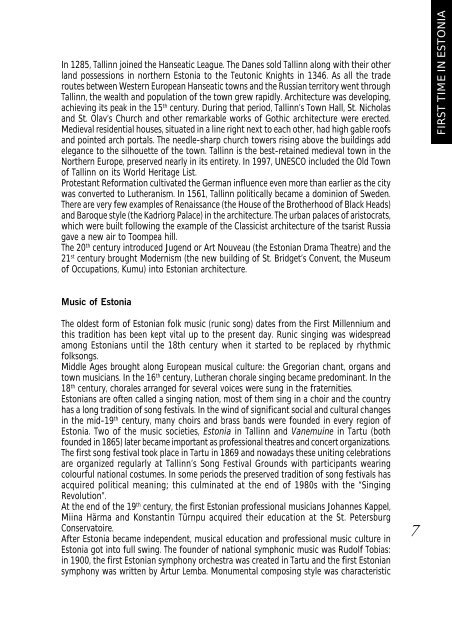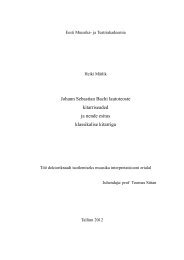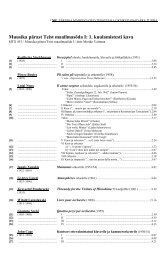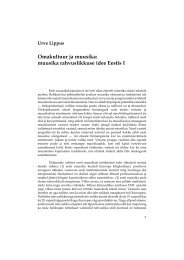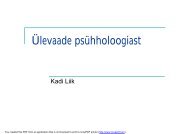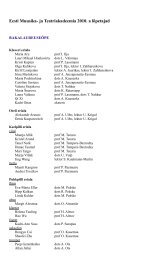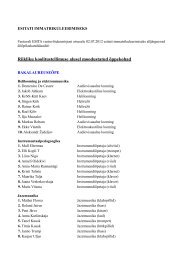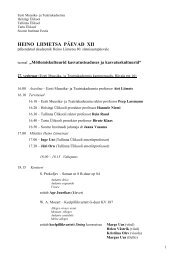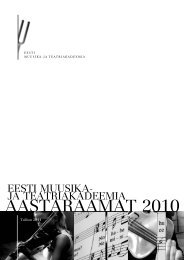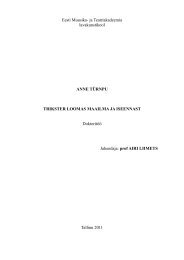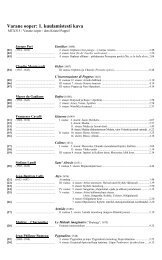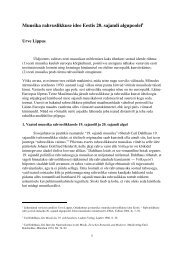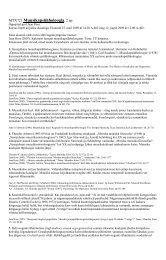You also want an ePaper? Increase the reach of your titles
YUMPU automatically turns print PDFs into web optimized ePapers that Google loves.
In 1285, Tallinn joined the Hanseatic League. The Danes sold Tallinn along with their other<br />
land possessions in northern Estonia to the Teutonic Knights in 1346. As all the trade<br />
routes between Western European Hanseatic towns and the Russian territory went through<br />
Tallinn, the wealth and population of the town grew rapidly. Architecture was developing,<br />
achieving its peak in the 15 th century. During that period, Tallinn’s Town Hall, St. Nicholas<br />
and St. Olav’s Church and other remarkable works of Gothic architecture were erected.<br />
Medieval residential houses, situated in a line right next to each other, had high gable roofs<br />
and pointed arch portals. The needle-sharp church towers rising above the buildings add<br />
elegance to the silhouette of the town. Tallinn is the best-retained medieval town in the<br />
Northern Europe, preserved nearly in its entirety. In 1997, UNESCO included the Old Town<br />
of Tallinn on its World Heritage List.<br />
Protestant Reformation cultivated the German influence even more than earlier as the city<br />
was converted to Lutheranism. In 1561, Tallinn politically became a dominion of Sweden.<br />
There are very few examples of Renaissance (the House of the Brotherhood of Black Heads)<br />
and Baroque style (the Kadriorg Palace) in the architecture. The urban palaces of aristocrats,<br />
which were built following the example of the Classicist architecture of the tsarist Russia<br />
gave a new air to Toompea hill.<br />
The 20 th century introduced Jugend or Art Nouveau (the Estonian Drama Theatre) and the<br />
21 st century brought Modernism (the new building of St. Bridget’s Convent, the Museum<br />
of Occupations, Kumu) into Estonian architecture.<br />
FIRST TIME IN ESTONIA<br />
Music of Estonia<br />
The oldest form of Estonian folk music (runic song) dates from the First Millennium and<br />
this tradition has been kept vital up to the present day. Runic singing was widespread<br />
among Estonians until the 18th century when it started to be replaced by rhythmic<br />
folksongs.<br />
Middle Ages brought along European musical culture: the Gregorian chant, organs and<br />
town musicians. In the 16 th century, Lutheran chorale singing became predominant. In the<br />
18 th century, chorales arranged for several voices were sung in the fraternities.<br />
Estonians are often called a singing nation, most of them sing in a choir and the country<br />
has a long tradition of song festivals. In the wind of significant social and cultural changes<br />
in the mid-19 th century, many choirs and brass bands were founded in every region of<br />
Estonia. Two of the music societies, Estonia in Tallinn and Vanemuine in Tartu (both<br />
founded in 1865) later became important as professional theatres and concert organizations.<br />
The first song festival took place in Tartu in 1869 and nowadays these uniting celebrations<br />
are organized regularly at Tallinn’s Song Festival Grounds with participants wearing<br />
colourful national costumes. In some periods the preserved tradition of song festivals has<br />
acquired political meaning; this culminated at the end of 1980s with the “Singing<br />
Revolution”.<br />
At the end of the 19 th century, the first Estonian professional musicians Johannes Kappel,<br />
Miina Härma and Konstantin Türnpu acquired their education at the St. Petersburg<br />
Conservatoire.<br />
After Estonia became independent, musical education and professional music culture in<br />
Estonia got into full swing. The founder of national symphonic music was Rudolf Tobias:<br />
in 1900, the first Estonian symphony orchestra was created in Tartu and the first Estonian<br />
symphony was written by Artur Lemba. Monumental composing style was characteristic<br />
7


